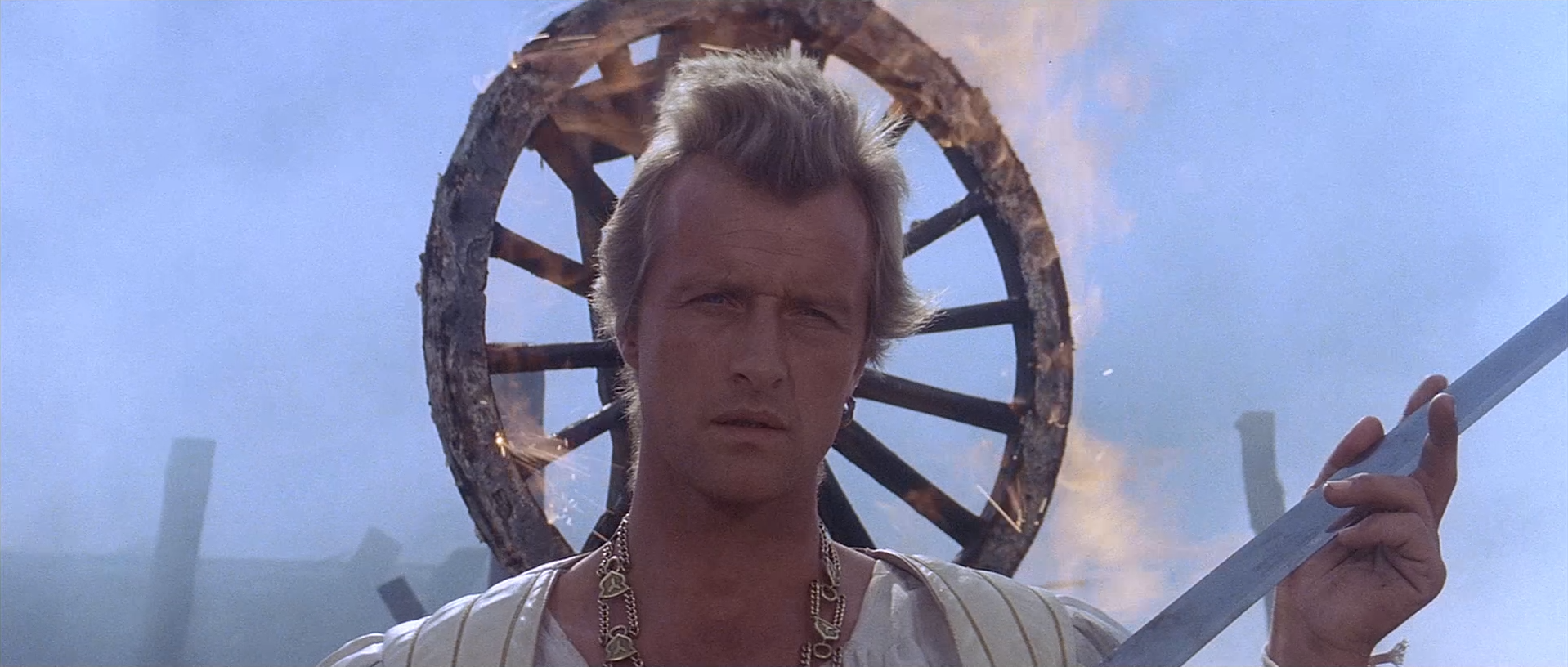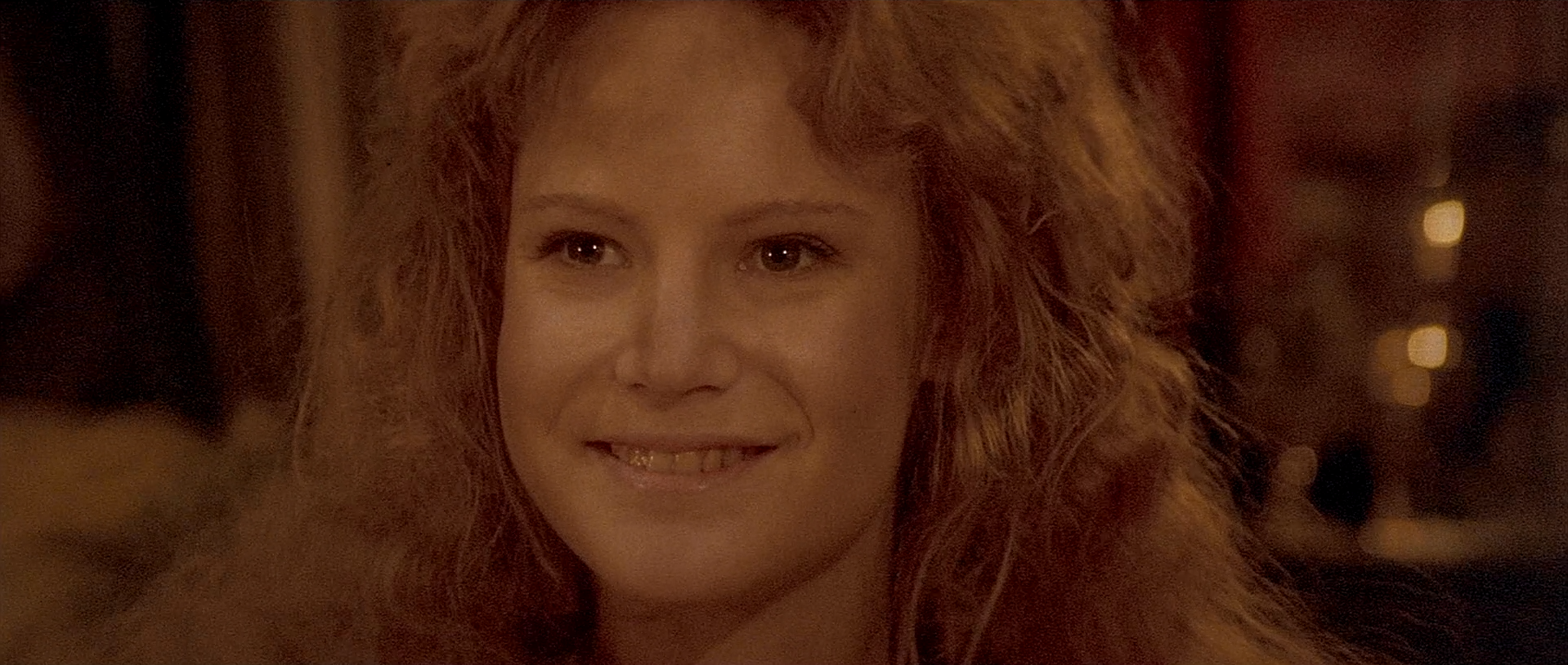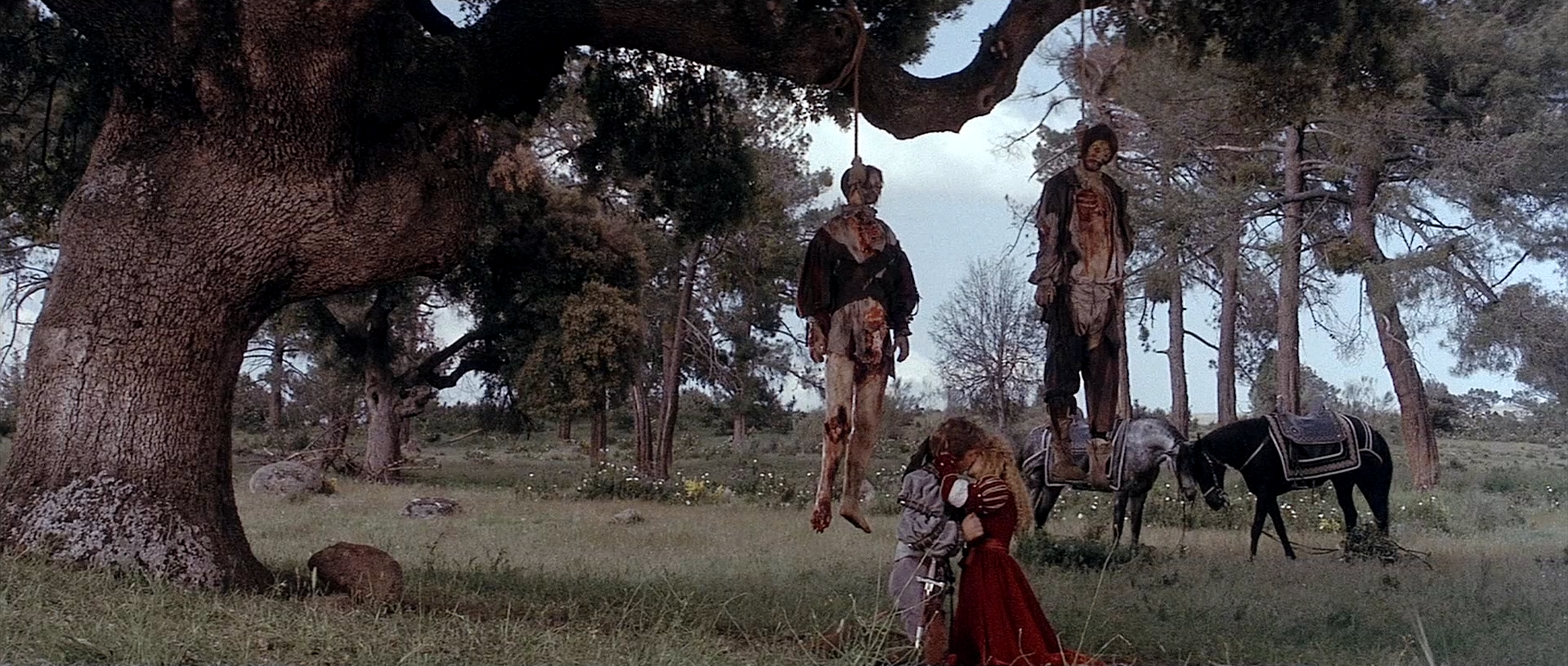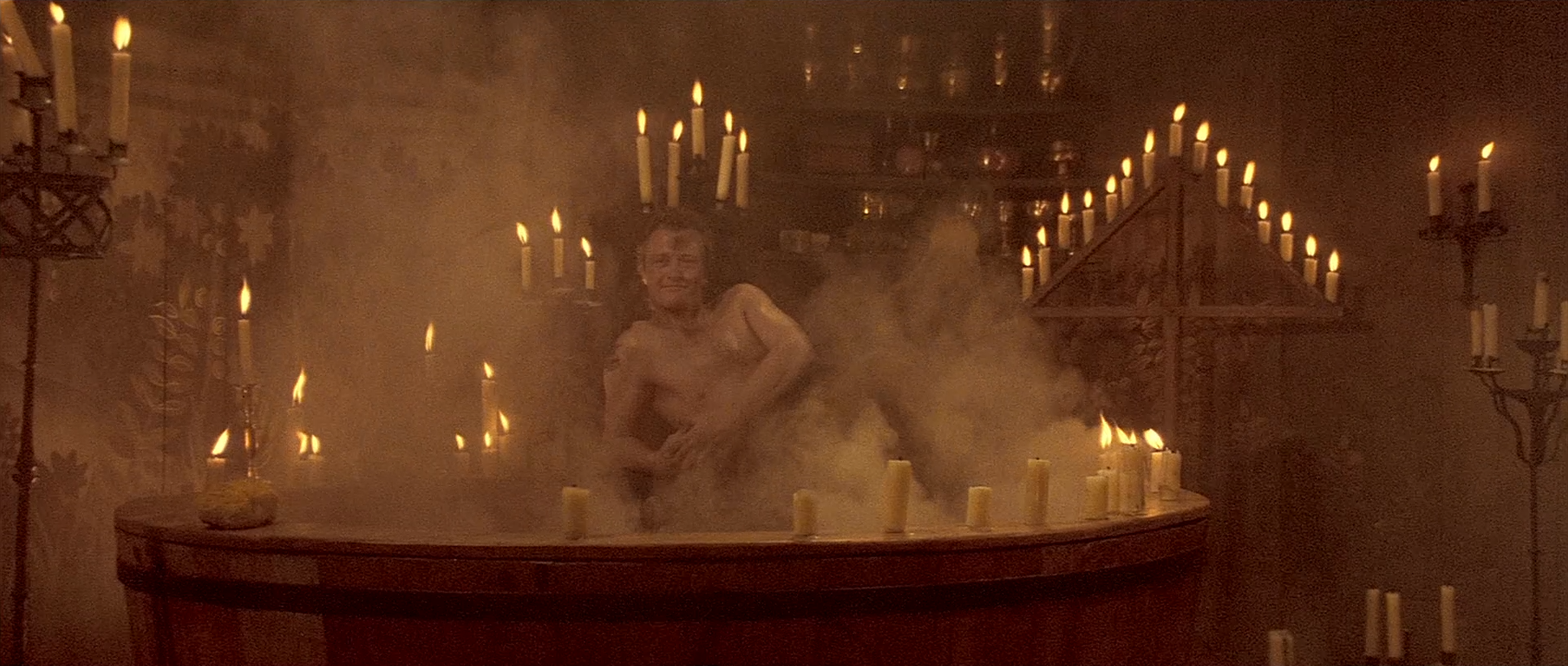| Reviews & Columns |
|
Reviews DVD TV on DVD Blu-ray 4K UHD International DVDs In Theaters Reviews by Studio Video Games Features Collector Series DVDs Easter Egg Database Interviews DVD Talk Radio Feature Articles Columns Anime Talk DVD Savant Horror DVDs The M.O.D. Squad Art House HD Talk Silent DVD
|
DVD Talk Forum |
|
|
| Resources |
|
DVD Price Search Customer Service #'s RCE Info Links |
|
Columns
|
|
|
Flesh + Blood
 When a noble lord named Arnolfini (Fernando Hilbeck) is forced out of his castle, he turns to his army, led by Sergeant Hawkwood (Jack Thompson), to help him get it back. He promises Hawkwood's men, including the devilish Martin (Rutger Hauer) freedom to rob and pillage from the rich when they reclaim the city, but Martin and the rest of the soldiers are so good at it that Arnolfini changes his mind and has them cast out, pressuring Hawkwood to comply when Hawkwood accidentally slashes a nun in the heat of battle. Empty-handed and miserable, Martin and his men are eager to listen to a cardinal in their group (Ronald Lacey) when they unearth a statue of St. Martin, and the cardinal has a vision of Martin leading them to riches. Instead, they find a beautiful young girl, Agnes (Jennifer Jason Leigh), whose kidnapping sets off a battle between the outcast soldiers and Arnolfini's son, Steven (Tom Burlinson).
When a noble lord named Arnolfini (Fernando Hilbeck) is forced out of his castle, he turns to his army, led by Sergeant Hawkwood (Jack Thompson), to help him get it back. He promises Hawkwood's men, including the devilish Martin (Rutger Hauer) freedom to rob and pillage from the rich when they reclaim the city, but Martin and the rest of the soldiers are so good at it that Arnolfini changes his mind and has them cast out, pressuring Hawkwood to comply when Hawkwood accidentally slashes a nun in the heat of battle. Empty-handed and miserable, Martin and his men are eager to listen to a cardinal in their group (Ronald Lacey) when they unearth a statue of St. Martin, and the cardinal has a vision of Martin leading them to riches. Instead, they find a beautiful young girl, Agnes (Jennifer Jason Leigh), whose kidnapping sets off a battle between the outcast soldiers and Arnolfini's son, Steven (Tom Burlinson).
Directed and co-written by Paul Verhoeven (his last Dutch film before making his American directing debut), Flesh + Blood is a rowdy portrait of medieval savagery. Verhoeven may not have a particular thematic point he intends to make with the movie, but he certainly has a worldview he wants to express, one which American movie studios would never be able to stomach. The film centers itself around the battle between Martin and Steven for Agnes' affections, but Verhoeven isn't going to let the audience off the hook by allowing either to be a "good guy" or a "bad guy." Both men have positive and reprehensible qualities, and Verhoeven constantly turns the tables on the viewer, pushing one aspect of a character's personality for an hour, only to suddenly turn around and highlight another.
Right from the beginning, Hauer's Martin is portrayed as different from even the rest of his crew, showing up late for the cardinal's sermon, shoving communion wafers in his mouth and begging him to bless him already so he can get to battle. There is a sense that Martin will be the craziest of them, the most violent, the least moral, but he is frequently the most thoughtful, weighing options, getting the lay of the land. When the gang finds Agnes hiding on a caravan stolen from Arnolfini, the men move to gang rape her. Martin steps in and rapes her first, which she tries to defuse by defiantly enjoying it, pulling him deeper into her. When he is finished, he steps aside, but quietly starts a fire that prevents anyone else from taking advantage.  No one could argue that Martin is heroic or selfless, but in a world where the majority of people are 90% immoral or criminal, a man with 40% of a conscience is better than nothing, and Agnes, a rich, bratty girl whose first sexual experience is with Martin, is honestly taken by his rebellious charm.
No one could argue that Martin is heroic or selfless, but in a world where the majority of people are 90% immoral or criminal, a man with 40% of a conscience is better than nothing, and Agnes, a rich, bratty girl whose first sexual experience is with Martin, is honestly taken by his rebellious charm.
On the flip side of this coin is Steven, who has ideas about elaborate war machines and engineering that his father seems to regard as a silly hobby. When Arnolfini throws Martin and the men out on their ear after reclaiming the castle, he stops just short of spitting in his father's face, bristling at the sliminess of it. His father is also the one who arranges for him to be married to Agnes, and he tries to get out of it, but he is smitten with her attitude upon meeting her. Although he is set up as a man who resents his father's two-faced ways, he has no qualms strong-arming Hawkwood out of retirement in order to try and rescue Agnes. He and Agnes spend hardly ten minutes with one another before the caravan is jumped and Agnes is taken away, but once she is gone, his desire to reclaim her knows no bounds. In England during the 1500s, the Black Plague was spreading, and Steven uses this to his advantage in a fairly horrifying way.
The contrasts trickle on down from there, including Agnes' simultaneous desire to be rescued and to stay with Martin robbing and pillaging, Martin's former lover alternating between wild abandon and heartbreak over his new relationship with Agnes, and the cardinal's visions, which he seems to be unsure about, but has enough conviction to lash himself for misinterpreting them. The film itself jumps from quiet, thoughtful scenes between Martin and Agnes to violent battles filled with rivers of blood. In one of the moments that most perfectly sums up Verhoeven's vision, Agnes digs for a "mandrake", which is meant to instantly bond two people who eat a piece of the same one in eternal love. The mandrake only grows under the bodies of hanged men, whose semen spills on the ground and causes the mandrake to grow. Agnes finds a root and shares a piece with Steven, and they embrace underneath the rotting corpses. For Verhoeven, these contradictions are just like yin and yang, two opposites that form a whole. Even the title is not "Flesh and Blood" but Flesh + Blood -- not a pairing, but a sum.
 The Blu-ray
The Blu-ray
Flesh + Blood arrives on Blu-ray with its original poster art intact. Admittedly, the DVD art wasn't anything special, just an artistically generic but technically sound Photoshop job, but I personally don't find this poster to be that much better, featuring the same "big head" set-up and really mediocre caricatures of Hauer, Leigh, and Burlinson. Disappointingly, a better painted poster existed, featuring Hauer embracing Leigh over another image of Hauer charging with his sword out, but for whatever reason, this one was chosen instead. The title also feels a bit cramped shoved down to the bottom edge of the art. The back cover is extra-simplified, mostly white text on a black backdrop. I'm used to Kino's really swanky Blu-rays with matte slipboxes, so this feels like a step down. The disc comes in a standard non-eco Viva Elite, and there is no insert.
The Video and Audio
Kino offers Paul Verhoeven's complete cut of Flesh + Blood in a 2.39:1 1080p AVC presentation. Coincidentally, I saw Flesh + Blood for the first time just about a month ago via MGM's OOP DVD, and its shortcomings were quite apparent -- strong shades of a single color caused problems, as did constant smoke or steam. This new Blu-ray offers a noticeable uptick in clarity, but it seems very likely that whatever source was used for the DVD is the basis for this HD presentation. In low-light scenes, the resolution of the grain practically transforms the image into a Seurat painting, made up of little dots as opposed to more finely resolved texture. In motion, from a proper distance, on an average-sized HDTV, this looks fine, but those with larger projection screens or those who pause and / or go in for a closer inspection will likely be frustrated by the appearance of the image. Details are resolved with far more clarity -- this is definitely HD -- but it's clear that another dimension of the picture is being lost with this dated scan. Colors also improve, but are inconsistent (in one shot, it's hard to tell if the distinct difference in the red of Brion James' outfit compared Simon Andreau's is the color of the outfits or the color of the transfer). There is some depth, but it is muted by weak contrast, robbing the picture of rich or inky black levels. At times, the image can appear sharpened, but to my eye this is part of the transfer and not something Kino applied after the fact. Fans of the film will probably be happy enough with the advantages this has over the DVD version, but Flesh + Blood could almost certainly have been further improved.
Sound gets a similar upgrade in the form of a DTS-HD Master Audio 2.0 track, which has a bit more breathing room and vibrancy than the DVD's audio, but is not a complete transformation. Flesh + Blood is packed with all kinds of action, from swordplay during a siege to a one-on-one fistfight inside a bedchamber, and all of it sounds really nice. Music has an extra touch of clarity and dimension as well. English subtitles (not captions) are also included.
 The Extras
The Extras
Kino ports the same two extras that were present on MGM's DVD version of the film: an excellent audio commentary by director and co-writer Paul Verhoeven, and a featurette on Basil Poledouris' score. Kino has started to produce new extras for their MGM acquisitions, and a new interview with Rutger Hauer would've been a really great cherry on top, but some companies wouldn't have retained what the previous disc had, so this is also just fine, all things considered. An original theatrical trailer is also included.
Conclusion
Verhoeven's version of medieval England feels like an attempt to reclaim it from the clean and classy action / romances of old Hollywood, an attempt to bring it to life in all its ambiguous, occasionally stomach-churning glory. It's a raucous, red-blooded picture that blows in like a storm, a tornado of religious symbolism, sexual aggressiveness, and brutal violence. The transfer is not as good as it could be, but Kino's new Blu-ray is an upgrade over the DVD. Recommended...for those who have the fortitude.
Please check out my other DVDTalk DVD, Blu-ray and theatrical reviews and/or follow me on Twitter.
|
| Popular Reviews |
| Sponsored Links |
|
|
| Sponsored Links |
|
|
| Release List | Reviews | Shop | Newsletter | Forum | DVD Giveaways | Blu-Ray | Advertise |
|
Copyright 2024 DVDTalk.com All Rights Reserved. Legal Info, Privacy Policy, Terms of Use,
Manage Preferences,
Your Privacy Choices | |||||||













